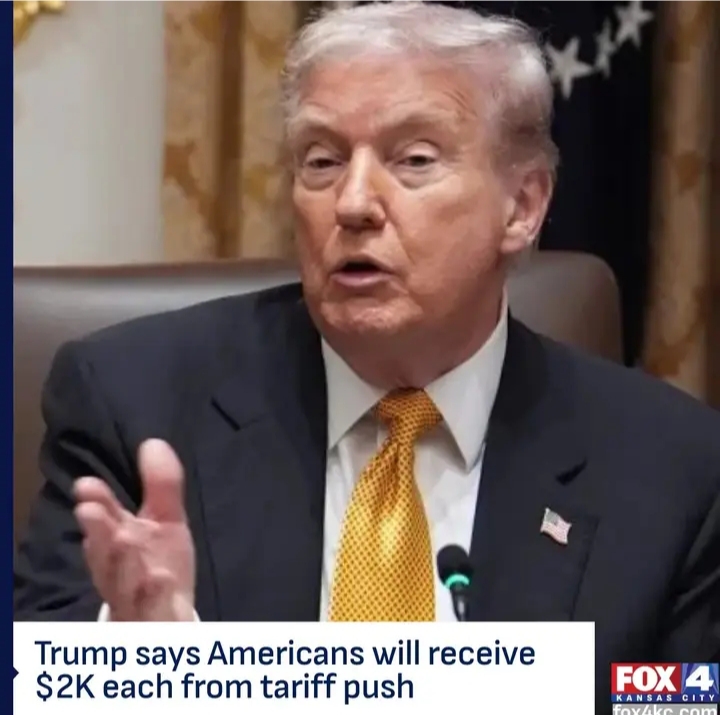CELEBRITY
President Trump said that each American will receive at least $2,000 from tariff revenue collected by the administration. See full details here

President Trump said that each American will receive at least $2,000 from tariff revenue collected by the administration.
**What’s being proposed?**
President Trump announced via his social media platform that most Americans — excluding high-income individuals — will receive a payment of at least **$2,000 per person**, financed by revenues from tariffs collected by his administration. ([People.com][1]) He described this as a “dividend” from what he calls a booming U.S. economy under his trade policies.
**What’s the rationale?**
Trump argues that the U.S. is now “the richest, most respected country in the world,” citing strong stock markets, rising 401(k) balances and investment in factories. He claims tariffs are generating “trillions of dollars” and that part of this windfall should be returned to Americans and also used to begin paying down the national debt (which he says is about $37-38 trillion). ([euronews][3]) By framing the payout this way, the administration is presenting tariff policy not only as protectionist/trade-oriented, but also as directly beneficial to citizens.
**What details are clear — and what aren’t?**
* Clear: The figure of **$2,000 per person** has been floated. ([Business Today][4])
* Clear: It is directed at “not high income people,” though the income threshold is not specified. ([Benzinga][5])
* Unclear: The mechanism (physical check, tax rebate, direct deposit) is not specified; Treasury Secretary Scott Bessent said it “could come in lots of forms,” including tax breaks (e.g., no tax on tips, no tax on overtime, additional deductions). ([Benzinga][5])
* Unclear: Timing and eligibility rules remain vague. It remains hypothetical and would require legislation or administrative rule-making. ([euronews][3])
**What are the economic & legal issues?**
* **Revenue vs. cost**: Analysts at the Tax Foundation estimate that paying $2,000 to, say, 150 million adults (excluding high-income earners) would cost around **$300 billion**. ([CBS News][6]) But the tariff revenue collected so far is about **$195 billion** in duties for the year to date (not all of which may be net “surplus” revenue). ([Benzinga][5]) Further, some of the tariff revenue is offset by lost tax income and other economic costs. ([CBS News][6])
* **Legal & institutional viability**: Many of the tariffs themselves are under legal challenge (including before the Supreme Court of the United States) for possibly exceeding presidential authority under the emergency-powers law. ([euronews][3]) If part of the tariff program is struck down or reversed, the revenue basis for the dividend would be undermined.
* **Inflation / burden trade-off**: Tariffs raise prices for consumers (imported goods cost more, some of the cost is passed to consumers) — so while a $2,000 payment is helpful, the underlying policy may impose new burdens. Some commentators note the “dividend” may partly offset higher costs, but not fully. ([Benzinga][5])
* **Budgetary and policy trade-offs**: Using tariff revenue for direct payments means less revenue for other priorities (e.g., debt reduction) or more borrowing if payments exceed revenue. The administration is simultaneously talking about paying down debt and providing this dividend. That creates tension in budgeting.
**Implications and take-aways**
If implemented, this plan could appeal politically (direct benefit to many Americans) and reinforce the narrative that trade protectionism can yield direct personal gain. However, its actual implementation faces hurdles: legal authority, fiscal feasibility, identifying beneficiaries, ensuring the payment doesn’t generate unintended negative effects (inflation, consumer price increases, budget stress).
For people watching:
* Pay attention to how Congress and the Treasury define “high income” and eligibility.
* Watch for whether the payout comes as a cheque, tax credit, or other form.
* Monitor developments in the legal challenges to the tariffs — the outcome may affect how much revenue is available.
* Consider the broader economic context: tariffs may bring revenue, but they also raise costs for importers/consumers, can provoke retaliation, and impact supply chains.












